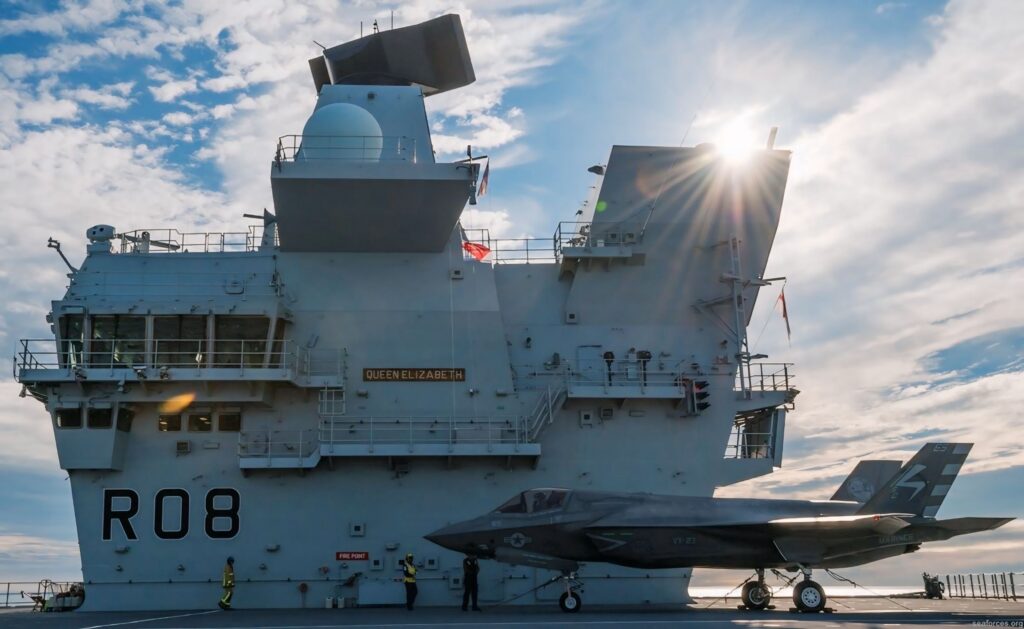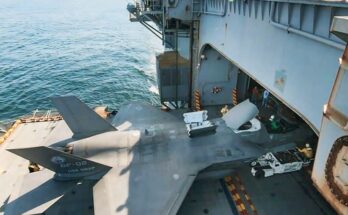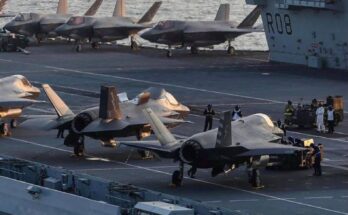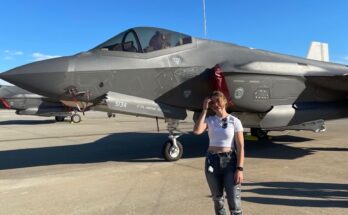
HMS Queen Elizabeth (R08) is the largest and most powerful warship ever built for the Royal Navy. Named after the Tudor monarch Queen Elizabeth I, the carrier represents a new era in British naval aviation. Launched in 2014 and commissioned in 2017, she is the lead ship of the Queen Elizabeth-class, accompanied by her sister vessel HMS Prince of Wales. Together, they form the backbone of the UK’s maritime strike capability.
Measuring 280 metres in length and displacing around 65,000 tonnes, HMS Queen Elizabeth is a floating air base designed to project power at sea and ashore. Her flight deck is expansive, covering an area equivalent to three football pitches, and features the iconic ski-jump ramp that allows short take-off and vertical landing (STOVL) aircraft to operate effectively. Unlike traditional catapult-assisted carriers, this design was chosen to accommodate the F-35B Lightning II stealth fighter, which can hover, land vertically, and take off over shorter distances.
The carrier can embark up to 40 aircraft in wartime, though her usual complement is a mix of F-35Bs and helicopters. The air wing often includes Merlin helicopters equipped for anti-submarine warfare and airborne early warning, giving the ship both offensive and defensive strength. With advanced radar systems, command facilities, and the ability to host coalition aircraft, HMS Queen Elizabeth is built not only for national defence but also to operate seamlessly with NATO and allied forces.
Life on board reflects the scale of the ship. She has a ship’s company of around 700 sailors, which increases to about 1,600 when the air wing is embarked. Facilities include medical suites, gyms, workshops, and accommodation designed for long deployments. Despite her size, the ship is run with modern efficiency, relying on automation and carefully managed systems. Two Rolls-Royce Marine Trent gas turbines, alongside four diesel generators, provide the power needed to run both the ship and its advanced equipment.
Since commissioning, HMS Queen Elizabeth has played a central role in demonstrating Britain’s global reach. In 2021, she led Carrier Strike Group 21 on a seven-month deployment to the Mediterranean, Indian Ocean, and Pacific. The deployment included exercises with allies such as the United States, Japan, and Australia, underlining the ship’s role as a symbol of Britain’s commitment to international security. Her embarked F-35B jets, drawn from both the Royal Air Force and the United States Marine Corps, flew operational missions over the Middle East during this tour.
Beyond combat operations, HMS Queen Elizabeth serves as a platform for humanitarian assistance and disaster relief when needed. Her ability to carry helicopters, supplies, and personnel makes her adaptable to a range of missions. She also provides a highly visible demonstration of British naval engineering and industrial capacity, having been constructed across multiple UK shipyards before being assembled in Rosyth, Scotland.
HMS Queen Elizabeth (R08) is more than just a ship; she is a symbol of national pride and strategic intent. As she sails into the coming decades, she will continue to represent Britain’s ability to project air power, support allies, and safeguard global maritime routes.


